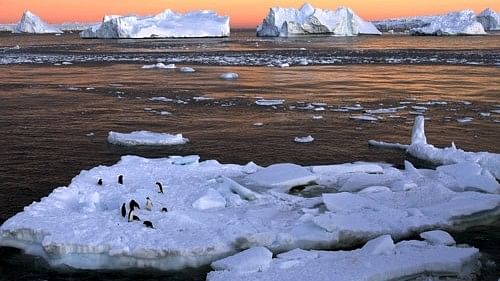
Representative Image of melting Antarctic ice sheet.
Credit: Reuters Photo
At the bottom of the world, the floating edges of one of the enormous ice sheets covering Antarctica are facing an invisible threat, one that could add to rising sea levels around the globe. They are melting from below.
As the planet warms, larger volumes of warm water are bathing the undersides of West Antarctica’s ice shelves, the giant tongues of ice at the ends of glaciers. The sheer mass of these shelves stops the ice on land from flowing more quickly into the open sea. So as the shelves melt and thin, more of the land ice moves toward the ocean, eventually contributing to sea level rise. Curbing fossil fuel emissions might help slow this melting, but scientists haven’t been sure by how much.
Now, researchers in Britain have run the numbers and come to a sobering conclusion: A certain amount of accelerated melting is essentially locked in. Even if nations limited global warming to 1.5 degrees Celsius, or 2.7 Fahrenheit, it wouldn’t do much to halt the thinning. Staying below 1.5 Celsius is the most ambitious aim of the Paris Agreement, and at the moment, it is unlikely to be achieved.
“It appears that we may have lost control of the West Antarctic ice-shelf melting over the 21st century,” one of the researchers, Kaitlin A. Naughten, an ocean scientist with the British Antarctic Survey, said at a news briefing. “That very likely means some amount of sea level rise that we cannot avoid.”
The findings by Naughten and her colleagues, published Monday in the journal Nature Climate Change, add to a litany of gloomy prognostications for the ice on the western side of the frozen continent.
Two of the region’s fastest-moving glaciers, Thwaites and Pine Island, have been losing vast amounts of ice to the ocean for decades. Scientists are trying to determine when greenhouse-gas emissions might push the West Antarctic ice sheet past a “tipping point” beyond which its collapse becomes rapid and hard to reverse, imperiling coastlines worldwide in the coming centuries.
“We can still save the rest of the Antarctic ice sheet,” said Alberto Naveira Garabato, an oceanographer at the University of Southampton who wasn’t involved in the new research, “if we learn from our past inaction and start reducing greenhouse gas emissions now.”